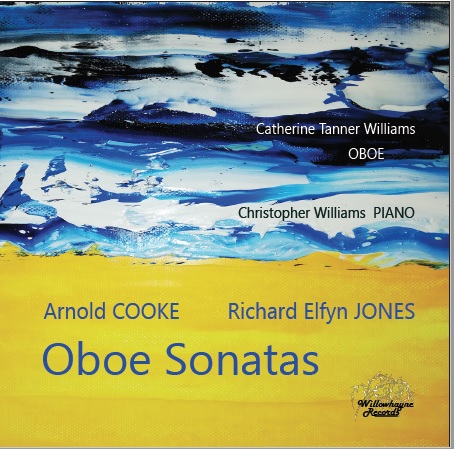
COOKE: Sonata for Oboe & Harpsichord or Piano. Sonata for Oboe & Piano. R.E. JONES: Sonata for Oboe & Piano – Viva Altea! C. WILLIAMS: Luminous. Darkness Falling with Birdsong / Catherine Tanner Williams, ob; Christopher Williams, pno / Willowhayne Records WHR063
I wanted to review this CD primarily because I was quite impressed, in other releases, with the music of Arnold Cooke, who wrote two of the three sonatas presented here. I was not disappointed in that respect. From the very opening of the Sonata for Oboe & Harpsichord or Piano, played here on the latter instrument, I was impressed by the late British composer’s intelligence and ingenuity. Cooke’s music, for those who haven’t heard it, is conventional in its use of form and rhythm but highly imaginative in his use of harmony. The music is primarily bitonal rather than atonal; by using rootless chords and constantly shifting the harmony around as the piece progresses, Cooke was able to convey an essentially lyrical mood without boring the listener with ordinary chord patterns, and his liveliness of rhythm here gives the music a rather upbeat feeling despite the constantly shifting chords. Even within the first movement, there are also general tempo changes from slow to fast, then back and forth again as the music develops.
The second movement is quite pastoral, and the harmony Cooke set up almost sounds a bit Oriental, though this feeling also shifts and changes as the music develops. Catherine Tanner Williams’ bright, penetrating tone is perfect for this music. Her pianist-husband, Christopher Williams, is also a fine musician though I felt that his contribution was a bit more generic in feeling. The last movement of this sonata is whimsical in a devil-may-care sort of way, the music obviously meant to entertain the listener as well as engage his or her mind in the shifting harmonies.
The second Cooke sonata here was written in 1957 for the famed British virtuoso Leon Goossens. The opening movement is extremely tuneful, again, in the solo oboe line, emphasizing the pure legato for which Goossens was famous. Hearing these two sonatas back-to-back, however, one notes a sameness in both material and rhythm in their first movements, which sound as if they stemmed from the exact same template or sketches. The second movement, however, is quite different from its successor, being in a more regular pulse and lacking the Orientalisms of the later work. This third movement, though also somewhat playful, is a bit meatier in its use of material and less airy-whimsical despite a similar tempo. Parts of it are set in 6/8, with almost the feel of British folk dances, albeit with far more sophisticated harmony lifts it above that genre.
Following the Cooke works is the oboe sonata of one Richard Elfyn Jones, a Welsh composer who, to my ears, follows in the footsteps of Cooke as a composer. My ears told me, however, that his music is much more glib and less substantial overall than Cooke’s, and this was in part confirmed by the credits that list him as a composer of music for the Maryland PBS TV series After the Warming and Timeline. Once you step into the worlds of TV or movie score writing, your style becomes compromised in the sense that you begin writing more populist and less purely artistic works. Not that this oboe sonata is a bad work; it’s just very predictable in how the music goes when compared to Cooke’s pieces. I did, however, like the third movement, titled “Barullo!,” very much indeed. It has a sort of Latin jazz swagger to it that is infectious along with interesting harmonic changes, and Tanner Williams is fully up to the challenge—rare for a classically-trained oboist.
Williams’ own piece, Luminous, is a surprisingly original upbeat number using lively, fast-paced eighth-note figures that rise and fall in thirds as the music goes through several harmonic changes, then falls back to a lyrical interlude before resuming its rapid, serrated little path with variations. In this piece, too, Christopher Williams sounded livelier and more fully engaged. At 4:35 the music slows down and in fact comes to a dead stop before resuming its jolly pace in the finale. Williams throws in a swinging passage in more relaxed tempo just before the final chord.
Darkness Falling With Birdsong is one of those nature pieces which hope to capture the feeling one gets from observing everyday events in the earth’s cycle. It’s a very nice little piece, pastoral and warm, with a relaxed feeling about it.
This is one of those rarities, an oboe recital that is uplifting and entertaining in addition to presenting some very good music. I like it overall.
—© 2020 Lynn René Bayley
Follow me on Twitter (@Artmusiclounge) or Facebook (as Monique Musique)
